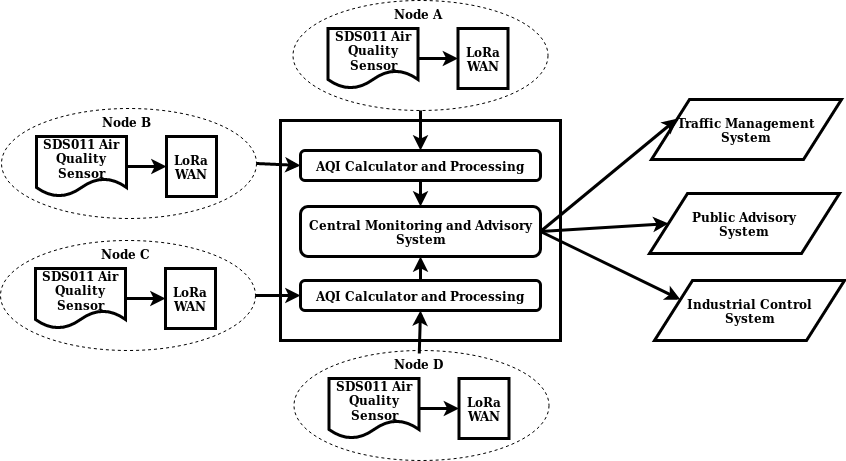Abstract
Air pollution is one of the major factors in deteriorating human health and also contributing to environmental degradation. According to World Health Organization around 7 million people around the globe die due to exposure of the fine particles contained in the air. It is estimated that around 35000 people die due to air pollution in Nepal annually. Continuous exposure to Air Pollution can cause several diseases like strokes, Heart disease, Lung cancer and chronic Respiratory diseases. Particulate matter less than 10 microns (PM10) can enter into our lungs and less than 2.5 microns (PM2.5) can enter into our bloodstream. It is important and responsibility of every human being to maintain a good Air quality Index for better life and environmental aspects .Rapid urbanization and industrialization without proper measures to reduce air pollution has contributed a lot in air pollution. Recently developed countries are working towards reducing carbon emissions and developing carbon capture and storage (CCS) technologies. In context of Kathmandu Valley major places are continuously exposed to the higher concentration level of the particulate matters which is significantly affecting the health of the people. The major air pollution in Kathmandu city is caused due to emission from vehicles, dust particles, and burning fossil fuels. Though several awareness and activities are conducted to reduce the air pollution in Kathmandu city it still lacks far behind which requires a good framework and policies. This paper analyses the air quality index of the Kathmandu city in real-time and propose the model based on internet of Things (IoT) technology and recommendation to alleviate air pollution and improve air quality index.
Index Terms – Air Pollution, Particulate Matter, PM2.5 ,PM10, IoT
Introduction: Air Pollution
- Air pollution is one of the major factor in deteriorating human health. According to World Health Organization around 7 million people around the globe die due to exposure of the fine particles contained in the air [1].
- It is estimated that around 35000 people die due to air pollution in Nepal annually[2].
- Air Pollution is major contributor to Global warming and climate change. https://bit.ly/itcon2019
Background Study
- The Air Quality Index AQI Provides the level of air pollution and associated health effects which might be experienced within a few hours or days after breathing polluted air.
- Particulate matter less than 10 microns (PM10) can enter into our lungs and less than 2.5 microns (PM2.5) can enter into our blood stream.
- Five major air pollutants :Ground-level ozone, particle pollution , carbon monoxide, sulfur dioxide, and nitrogen dioxide. (BaP-BenjoaPyrene
Air Quality Index Scale (0-500)

Impact of Air Pollution on Human Health

Scenario of Air Pollution in Kathmandu


Vehicles Registered in Bagmati Zone, Year: 2015 - 2018

Monthly Average AQI of Kathmandu, Year: 2017- 2019

Season wise Average Variation of AQI in Kathmandu, Year: 2017-2019

Day wise Variation of AQI in Kathmandu, Year: 2019

Government Inititaves
- The Air Quality Index AQI Provides the level of air pollution and associated health effects which might be experienced within a few hours or days after breathing polluted air.
- Particulate matter less than 10 microns (PM10) can enter into our lungs and less than 2.5 microns (PM2.5) can enter into our blood stream.
- Five major air pollutants :Ground-level ozone, particle pollution , carbon monoxide, sulfur dioxide, and nitrogen dioxide. (BaP-BenjoaPyrene
The Constitution of Nepal 2015 has mentioned that clean and healthy environment should be guaranteed to the people as their primary right [1]
Various Policies and task force have been formed [1],[2],[3] but mostly remains ineffective.
To name few:
Air Particle Sensor and working Principle

Air Quality Index Calculation

Suggestions and Recommendation
- Efficient Traffic Management, Route Diversion, Variable working hours (not 10-5).
- Road department must be proactive and prompt on maintenance of roads (Potholes)
- Promote public transport, electrical vehicle, BiCycle (In Hongkong 85% of people use Public transport [9]).
- Trees that are suitable for Kathmandu’s climate should be planted throughout the city which absorbs airborne chemicals and releases oxygen.
- Public transport system must be made smart and operated in single window based on the routes
- Promote walking and cycling zone, (Tripureswor to Jamal)
- Use of clean energy
- Municipality should take strict action for improper constructions and wastage disposal.
- Remove brick Kiln from valley
- Make use of Pollution tax collected 50 paisa/ltr since 2007 (money remains unspent.[2]
